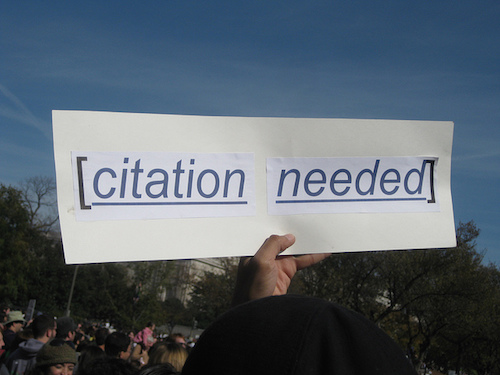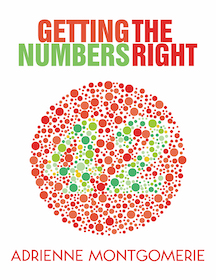Editing the references can take as long as it does to edit the document itself. Formatting is picky and slightly different for each style guide; information is out of order or missing; and citations are missing or not referenced in the document.
Editing Canadian English 3 (ECE3) and the updated Professional Editorial Standards say that an editor’s responsibility includes checking all of those aspects. Here’s a checklist to get you started, then a hint for using AI/GPT. Jot notes about the style for your own reference.
Citation V Reference
The citation is the part in the running text that attributes content to another creator. A reference is the full details of the source, given at the end or in a footnote. (See below for what and when to cite!)
A citation might look like the red parts of these examples, depending on the style being followed:
- As Darwin said in his book, On the Origin of Species, [quote or paraphrase].
- “I do love a locker room. It smells like potential.” (Ted Lasso E1S1)
And those inline citations might be formatted any of these ways, or a way unique to the publication (note the highlighted differences):
- (Darwin, 1859) or (Darwin 1859)
- (1) or [1] or 1 (or a letter)
- (Schellenberg E.G., Hallam S. 2025)
- (Schellenberg & Hallam, 2025)—or spell out and
- (Schellenberg et al. 2025)—or … in place of et al., or one of those only after a certain number of names (variously 7 to 19!), plus more finicky requirements
- (Darwin, 1859; Schellenberg, 2025)—in order of year (up or down) or alphabetically
- (Schellenberg 2025, Darwin 1859)—[see above note]
References V Bibliography
Where a bibliography lists sources for further information, a reference list contains the sources that were cited in the document. The items in a reference list are paired with their related content (a citation) within the body of the text by number or author name (and date).
Minute differences between reference formatting styles
Styles for the reference list entries have obvious differences like placing the year of publication at the end or right after the author names, but they have many minute differences too:
- Number of authors listed varies, as does the separator before the final name.
- First names might be spelled out or just initials; with or without periods and a space.
- Second author onward might be written in first-last name order.
- Authors beyond first, sixth, or any number might be replaced by an ellipsis or et al. (which may or may not be in italics).
- Titles of books/journals/etc. might be italicized.
- Titles might be set with capitals on most words or only the first.
- Article titles might be in quotes or not, with capitals on most words or only the first.
- Journal titles might be abbreviated.
- Volume and issue number might be in bold, italics, brackets, a combo or none.
- Page range is sometimes excluded or replaced by an article number.
- Page numbers might come at the very end, or somewhere before, using p. or not.
- DOI or link may be required (ISBN or ISSN are not).
- Elements might be separated by commas, periods, semicolons, brackets or no spaces.
Sample reference styles for a journal article
| AMA | Pedraza R, Nieto J, Ibarra S, Haas EM. Pelvic muscle rehabilitation: a standardized protocol for pelvic floor dysfunction. Adv Urol. 2014;2014:487436. doi:10.1155/2014/487436 |
| APA | Pedraza, R., Nieto, J., Ibarra, S., & Haas, E. M. (2014). Pelvic muscle rehabilitation: a standardized protocol for pelvic floor dysfunction. Advances in Urology, 2014(1), 487436. |
| Chicago (CMOS) | Pedraza, Rodrigo, Javier Nieto, Sergio Ibarra, and Eric M. Haas. “Pelvic muscle rehabilitation: a standardized protocol for pelvic floor dysfunction.“ Advances in Urology 2014, no. 1 (2014): 487436. |
|---|---|
| Harvard | Pedraza, R., Nieto, J., Ibarra, S. and Haas, E.M., 2014. Pelvic muscle rehabilitation: a standardized protocol for pelvic floor dysfunction. Advances in Urology, 2014(1), p.487436. |
| MLA | Pedraza, Rodrigo, et al. “Pelvic muscle rehabilitation: a standardized protocol for pelvic floor dysfunction.“ Advances in Urology 2014.1 (2014): 487436. |
| Vancouver | Pedraza R, Nieto J, Ibarra S, Haas EM. Pelvic muscle rehabilitation: a standardized protocol for pelvic floor dysfunction. Advances in Urology. 2014;2014(1):487436. |
Checklist for formatting references
Print out this handy checklist with tips for checking in-text citations and reference lists.
- Style being followed
- author/date
- numbered list
- note markers
- footnotes
- Citations in the text are listed in references
- and all references are cited in the text
- number sequence for in-text citations is correct that matches that in the reference list
- Entries are in alphabetical / numerical order
- for numerical entries, use this hack to check for duplicates
- use “Sort” for alphabetical
- Entries contain all necessary elements, usually: author(s), date, title, publication, and maybe city, page number and DOI
- in preferred order
- using preferred punctuation
- Works by multiple authors are cited with the appropriate
- number of author names
- use et al. or ellipses, ampersand, and or none
- Titles are accurate and
- use of quotation marks
- use of italics
- use of brackets
- Names are correctly spelled and formatted
- full first names or initials
- order
- Multiple papers by the same author are cited according to the specified style by
- ibid
- op cit.
- double/tripple em rule
- repeat all authors
- repeat only first authors
Automate reference editing
AI (GPTs, more properly) might be a better help for completing and formatting references than for doing anything else at this point. Simply tell the GPT to “format these references to XX style.” If you’re using a house style, just tell the GPT the order and formatting in minute detail, such as “put all names in all caps, then the year in brackets, then the title with only an initial capital letter…” etc.
The original and the output can be pasted into separate files to use the Compare Docs function to mark up the changes. (Turn off Track Changes in both files to paste the new “compared” list in place.) You may find that the GPT changes titles or names, do a quick check to verify they’re right; often they are.
“Because many writers use reference management software,” ECE3 says, “there is rarely a need to go back to the source of each reference to verify the citation elements. However, if elements are missing or confusing, it is advisable to check the reference against the original (if available in print or online) or against a standard indexing database.”
The “cite this” buttons on many journal sites can help, but they may contain errors because elements were not correctly tagged, are incomplete, or weren’t entered in the right fields. Beware!
What and When to Cite
“Citations are made to credit someone else with the idea, and also to point to experts to support your argument.” (SFU library guide)
If it’s someone else’s words or idea, credit them via a citation (or mention in some non-academic works).
“Commonly known or readily verifiable facts can be stated without quotation or attribution unless the wording is taken directly from another source.” (CMOS18, 12.6) But what is commonly known depends on the audience. It would not typically be necessary to cite Newton every time you talk about gravity, but a physics resource might!
In Western culture, it is common to repeat some well-known quotes without attribution — think “wherefore art thou, Romeo” or “live long and prosper”. But in publishing (or academia), we must cite the source.





